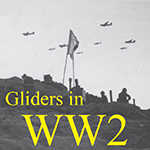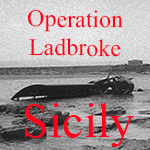Combining journalism with historical analysis, the articles on this website use battlefield visits and original research to bring to life the history of Operation Ladbroke, the Allied invasion of Sicily in 1943, and airborne assaults in World War 2. Previously unseen photographs and new discoveries will be published, and facts disentangled from myths.
Click on the images below to see the articles and posts:


Introduction
Operation Ladbroke is one of the most remarkable stories of the war. It was the opening move of Operation Husky, the Allied invasion of Sicily in July 1943. It saw the first mass use of glider troops by the Allied forces. Mistakes were made, losses were terrible, but the heroism of the airborne forces shone through. The seizing and holding of the Ponte Grande bridge, in particular, is the stuff of airborne legend.
The Red Devils (as their German opponents had christened them) were supported by raids on Italian heavy gun batteries by both the SAS and the Commandos. Meanwhile the main seaborne forces of General Montgomery’s Eighth Army raced to relieve the beleaguered glider men and capture the port of Syracuse.
In the following days further airborne assaults were intended to hold open a corridor for the Eighth Army, as it advanced up the coast of Sicily seizing port after port.
Less than a year later, during the D-Day invasion of Normandy, lessons learned in Sicily helped Allied airborne forces perform yet more outstanding feats of arms. Later still, at Arnhem, Montgomery repeated his strategy of an airborne-held corridor. It was a strategy first employed by the Germans during their invasion of Holland.
The story of Operation Ladbroke is an integral part of a larger history, and this website will also include stories from the wider invasion of Sicily and the history of airborne forces in the whole of World War 2.
See all the posts listed here.





Hello Ian
I’ve just read with interest your letter published in the latest edition of The Eagle.
I’m sure you are aware of the recent publication of my late father’s (Staff Sergeant V. Miller) book Nothing Is Impossible by Pen & Sword, which contains his account of his time in North Africa and his part in the operation.
Regards
Chris
Yes, “Nothing is Impossible” is one of the key books about Operation Ladbroke. It’s good that it has been reissued – it deserves to stay in print. See my review here.
Dear Chris,
I have just read the Arnhem chapters of your father’s book. Both of my parents were lifelong friends of the Hollingsworth family and my father was at school with Tom Hollingsworth. My parents knew about the film crew in his glider and also how he had been killed, but didn’t know what happened to him during the battle. Having grown up with the story reading the moment by moment description of your father’s experience and its references to Tom is quite fascinating. I wish that my parents had seen it and known the details.
Thanks for publishing it.
Many thanks for all your research on this often overlooked operation in WW2. I have found your website to be the only one to provide some real in-depth analysis and debate about the preparation, conduct and course of events in the operation. It has been fascinating to wander through the various items and different perspectives provided in your articles. Thank you also for publishing my own father’s role and story in the operation.
Hello Ian,
I’m writing to you concerning the Wellington wreck of Capo Murro.
I’m a friend of Fabio Portella, the guy who discovered the wreck underwater.
Me and Fabio 3 years ago discovered a C-47 off the coast of Syracuse, that was shot down during operation Fustian (you can see a short video here, https://www.youtube.com/watch?v=ajxWBlIQOIg&t=18s). After a long research we’ve managed to identified the C-47 serial no. and the crew members.
Now, I’m reading your story about the glider no. 57 and I think your hypothesis about the Wellington is very very interesting.
Have you got any document or reference about the squadron who attacked Syracuse the night of the 10th at 02:15 am?
We’d like to collect more data in order to identificate the wreck serial no.
Regards
Nicola
Nicola – good to hear from you. Wellingtons from 142 Squadron bombed the Syracuse isthmus with Ortigia at 2:15am. Marcon in ‘Assalto a Tre Ponti’ p28 has an account by a pilot, plus some photos and a document. Other eye-witness accounts by glider troops appear in Chatterton’s ‘The Wings of Pegasus’ p74 and here. The operations record of 142 Squadron for 1943 can be found at the National Archives. You can download PDFs for a fee. I’m sorry, but I do not have any details of serial numbers or crew members.
I’ve done some more research. There is no record of 142 losing an aircraft, but Wellingtons from 424 and 37 were also over Syracuse that night, and both lost an aircraft. The ops records of 424 show that its planes were there at the same time as 142, but it lost no planes over Sicily. This leaves 37, one of whose planes, HE756, did indeed fail to return. Sgt W L Ball and 5 crew were posted MiA. Perhaps that is your Wellington. The ops records for 37 have not been digitized by the NA, so unless there is another source somewhere, they can only be seen at the NA in Kew.
Thanks very much for sending through some detailed information on HE756. It makes it seem highly likely that HE756 is your wreck. I made a mistake yesterday when I said 37’s ops records cannot be downloaded – they can, here. F/Sgt Ralph of 37 saw an aircraft crash “N of Cape Murro di Porco”. Although this says that the plane crashed on land, not in the sea, it does put the crash in the right area to be your wreck. The lack of any other candidates, plus the numerous eye-witness accounts by glider troops, suggest Ralph may be mistaken about the “North” part of his statement.
The finished article about the mystery bomber appears here.
Hi Ian,
I was browsing the internet and found the story
https://xray-mag.com/content/british-ww2-bomber-found-sicily
My grandfathers wellington also ditched in the Mediterranean 27th of Feb 1943 while posted in the 458 Squadron RAAF
This is a photo on the AWM website of the crew getting rescued by SS Destro
https://www.awm.gov.au/collection/C273560
I have all the ORB’s and incident records if you would like to see more
Thanks Nick. The Syracuse bomber in your link is the one mentioned in my story about Glider 57. As you can see from my conversation with Nicola Giusti above, we have now identified the Wellington in question and have the names of the crew. I’m about to post the story of the bombing that night.
Fascinating to see the photo of your namesake being rescued from the Med. In case other readers are interested, Nick’s 458 Squadron website can be found here.
I have now posted the article about the mystery bomber. It appears here.